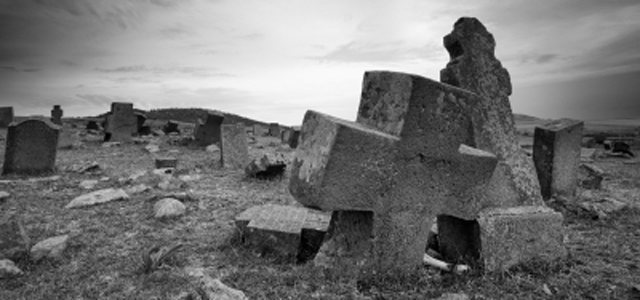The Grave: No Sting, No Victory
May 1, 2009

Puff was dead. For all my seven years, she’d been there. But now she was gone. At times, like a fierce tiger, she had chased stray dogs from our yard. At other times, she had rolled over on my lap as I rubbed her tummy and made the loudest purring noises imaginable for a cat.
But now she was dead. She had finally succumbed to old age. We dug a hole in the backyard and gently placed the shoebox containing her body in it. A few words of goodbye, and Puff the persian was gone.
For the first time in my short life, I understood the meaning of the word dead. Dead meant gone forever— or so I thought.
It broke my heart! I remember the whole family cried that night. Dinner was cancelled. No-one felt hungry— our stomachs were too knotted with grief. It hurt so much that I remember Dad saying we would never again have another animal. I think, though, that it was a mere six months before a Siamese stray, later named Nibs, made his home with us and stole our hearts again.
Since then, I’ve stood at the side of many a grave: as a grandson, wanting to be comforted; as a friend, hurt and confused; as a pastor, seeking words that would bring hope and ease the hearts of those who grieved. But from that first encounter with death, I began to ask questions, such as what happens to people when they die? Will I see them again? Can I talk to someone who has died? Is there life after death?
You can ask a thousand people these questions, and you’ll get a thousand different answers. So I turned to Scripture, and there in the authority of God’s Word, I found certainty, hope and the answers I was seeking.
life
“The earth was formless and empty, and darkness covered the deep waters” (Genesis 1:2, NLT).* In this succinct phrase, we are given a picture of a time of turmoil, chaos, darkness, hopelessness and emptiness on earth. It was our earth’s beginning. But God had a plan, and He began to act. What did He do?
He simply spoke, and from His Word came peace, order, light, hope and life.
Genesis 2 describes God creating Adam and Eve. It tells how He placed them in a Garden, how at the end of His creation He stopped creating and began resting. The Bible tells us that “on the seventh day God had finished his work of Creation, so he rested from all his work” (Genesis 2:2). And so Adam and Eve, together with God, experienced peace, order, light, hope and life—their first Sabbath.
death
So what happened? Why is the world today so different from the one the Bible says existed in the beginning?
Genesis 3 tells us that Adam and Eve sinned, and the world again became a place of turmoil, chaos, darkness, hopelessness and emptiness. The rest of Genesis tells us how sin spread among Adam and Eve’s descendants. No longer were peace, order, light, hope and life our only human experiences. All too quickly, flight, fear, pain and, finally, death became all too familiar.
Even Jesus knew what it was like to have a beloved friend die. The story is told in John 11. Jesus was ministering to the people with His disciples in an area near the Jordan River, south of the Sea of Galilee. Lazarus, Mary and Martha lived in Bethany, about three kilometres southeast of Jerusalem.
Their home was a three- or four-day walk from where Jesus was. We know Jesus and Lazarus were close. Mary and Martha had sent a messenger to tell Jesus that “your dear friend is very sick” (John 11:3). Jesus had healed many strangers, so Mary and Martha assumed that, if Jesus could just get there in time, He would surely heal His good friend, their beloved brother.
However, Jesus chose to remain where He was for another two days.
Finally, He said to His disciples, “Our friend Lazarus has fallen asleep, but now I will go and wake him up” (verse 11). The disciples were a little confused.
They said, “Lord, if he is sleeping, he will soon get better!” (verse 12).
The disciples thought a good night’s rest would help Lazarus along the road to recovery. But that is not what Jesus meant. “So he told his disciples plainly, ‘Lazarus is dead’” (verse 14). When Jesus and His disciples reached Bethany, Lazarus had been dead four days!
When Mary and Martha heard that Jesus was finally approaching Bethany, Martha went out to meet Him, while Mary stayed at home. From what we know of her in other stories, Mary tended to blame herself for the bad things that happened. She may have been angry with herself, and so her “if onlys” would most likely have been directed inward. Thoughts plagued her, such as, If only I’d gone to Jesus personally, or, If only I’d had enough faith, or, If only I’d prayed more earnestly, Lazarus wouldn’t have died. It’s all my fault! Maybe you’ve had similar thoughts.
Martha, however, met Jesus on the road, and her anger seems to have been directed outward, toward Jesus. Martha told Him exactly how she felt. “If only you had been here, my brother would not have died,” she said (verse 21). Anger is not an unusual response to death. You may have experienced it yourself. Even now you may have anger in your heart toward others: If only someone had been there! If only someone had done something! Where was God? Why did He allow this to happen?
When tragedy occurs, our typical human response is to try to make sense of it. How it happened—yes, we’ve heard that; when it happened— yes, we know that. But the question we may ask ourselves over and over and yet often find no answer is, “Why did it happen? It just doesn’t make sense.”
Many have been driven to the edge of despair trying to find an answer to these questions.
resurrection
Jesus didn’t offer an explanation to Martha. He said, “Your brother will rise again” (verse 23). Martha agreed, because she understood there will be a resurrection at the end of the age. But then Jesus made a bold statement. “I am the resurrection and the life,” He said. “Anyone who believes in me will live, even after dying’” (verse 25).
Martha then went to Mary. She told her Jesus had arrived and wanted to see her. So Mary went from their house to where Jesus was waiting and repeated Martha’s words, “Lord, if only you had been here, my brother would not have died” (verse 32).
Many friends and family members had followed Mary, thinking she was going to the grave. When Jesus saw their grief, John tells us that “a deep anger welled up within him, and he was deeply troubled” (verse 33). Jesus was angry at death itself. Death was an interloper. Death was never meant to be. Death was the opposite of what Jesus was all about. “The thief ’s purpose is to steal and kill and destroy,”
He once said. “My purpose is to give [everyone] a rich and satisfying life” (John 10:10).
But the story doesn’t end with Lazarus dead, asleep in the tomb. John retells the whole story as he saw it unfold about him. Jesus asked Mary where Lazarus’s body had been placed, and surrounded by mourners, they all began the journey to the tomb. It was then that Jesus became overcome by grief and wept (verse 35).
When they arrive at the tomb, Jesus instructed the people to roll the stone aside.
Martha quickly corrected Jesus.
Because her brother had been dead for four days, she said, “The smell will be terrible.” Jesus replied, “Didn’t I tell you that you would see God’s glory if you believe?” (verses 39, 40).
So the people rolled the stone away, and Jesus looked up to heaven and prayed. Then He shouted, “Lazarus, come out!” (verse 43). The French translation from the Greek text adds something to the meaning of Jesus’ words. It’s something like, “Lazarus, get out of there!” implying that Lazarus didn’t belong in the tomb.
One can imagine the crowd holding their breath, waiting to see what would happen. John, one of many eyewitnesses, wrote down exactly what happened: “The dead man came out, his hands and feet bound in graveclothes, his face wrapped in a headcloth” (verse 44).
Jesus then told them, “Unwrap him and let him go!” (verse 44).
This proved beyond a shadow of a doubt that Jesus really was the Resurrection and the Life, for Jesus called Lazarus, and Lazarus heard His voice and rose from the dead. The breath of God, the life force, was breathed back into Lazarus’s dead and decomposing body. Dead cells became alive again.
The heart began to pump again. The organs began to function again. And the man Lazarus, the brother of Mary and Martha, emerged from the tomb full of life again!
in conclusion
What happens to people when they die? The story of Lazarus makes it plain. They are resting. They are dead.
Their body will decay and finally return to dust. Will you and I see that person again? Jesus said, “I am the resurrection and the life. Anyone who believes in me will live, even after dying” (John 11:25). Jesus made it plain. Believe in Him and even though you may die, you will receive life again.
Is it possible to talk to someone who has died? Of course not! The story of Lazarus makes that plain. Just as in sleep we know nothing until the morning, so too the dead know nothing until Jesus calls them from their graves.
But is there life after death? Emphatically, Yes! Jesus did not simply talk about the power He had to bring the dead to life—He demonstrated that claim in front of many witnesses by bringing His friend Lazarus back from the dead.
The Bible makes plain that one day there will be life without the shadow of death lurking nearby. To be a part of that world is simple. In the words of Jesus Himself, “The one who believes in me, even though he or she dies, will live” (verse 25, The Message).
* Unless otherwise noted, Scripture quotations are taken from the Holy Bible, New Living Translation, S0509 copyright









